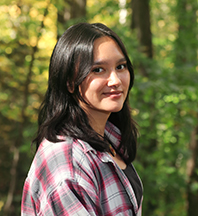Week of February 5, 2023 – February 11, 2023
by Sunny Guyette, Environmental Educator
The Baltimore Woods Nature in the City program visits every K-5 grade classroom in the Syracuse City School District three times a year for a one-hour hands-on/minds-on natural science lesson. The current lesson that we give to Kindergartners is “Animals in Motion”, where the educators have the pleasure of introducing how and why non-human animals move certain ways in order to survive. We do this by having the students explore three out of our five senses to understand how other local animals use their senses. First, we show them a taxidermied Grey Fox and go into detail about how Foxes have adapted to use their senses and move in certain ways to survive. We do this by showing them how they can walk silently, just like a fox, and by playing a listening game where students pretending to be mice have to sneak around the “fox” without being detected. Then we bring out three feely bags where students have to be brave enough to reach into a bag and try to guess what is in each bag. When they reach inside, they will find turkey feathers for flight, a beaver tail for swimming, and rabbit fur that helps with camouflage. We end with walking around the classroom and doing our best to copy different animal movements. The kids seem to really enjoy this lesson and I am so glad that I get to be one of the people that brings nature into the city through this program!
Before learning and teaching this lesson, I never really thought much about why other animals have evolved to move how they do. In the lesson I ask the kids if they think Turkeys can fly and most of the time they all say “No!”. I explain to them that they can fly, just not very far or very high and empathize with them by telling them I used to think that Turkeys could not fly, too. I continue with “Turkeys can fly into trees” and then ask, “why would they fly into trees?”. Most of the time at least one kid will respond with, “so they don’t get eaten”! This lesson is not only leading me to dive deeper into other animals’ lives, but it also allows the kids to explore and investigate why animals fly, hop, walk, run, swim, and so on.
Animals are all around us and always on the move, but it can be so easy to forget that we ourselves are animals too! I hope you can spend some time this week exploring how other animals move by just simply looking outside your window or observing the Stink Bug crawling on your wall! While observing, try and guess why a certain animal might move the way that they do and ask, “how does this help them survive?” Is it similar or different from the way you move?


